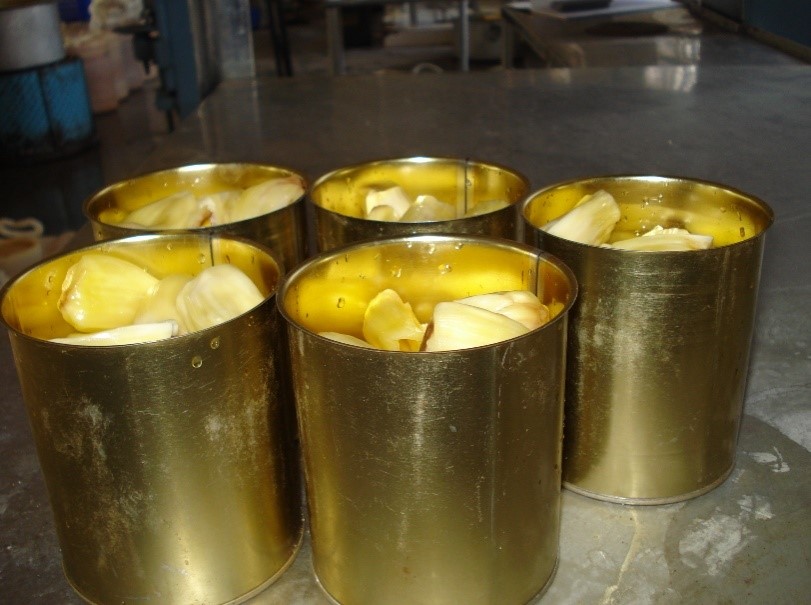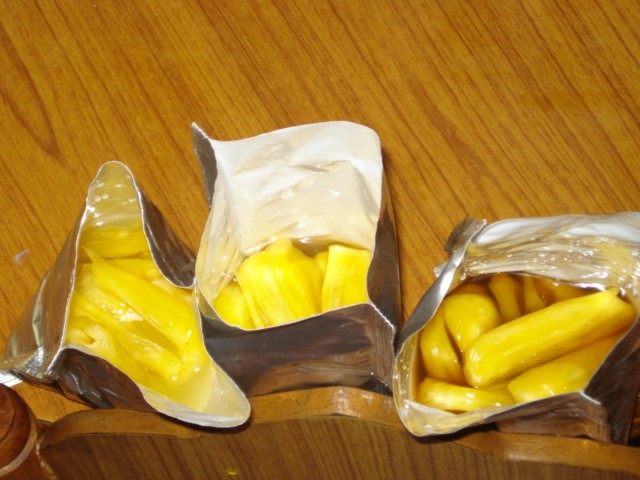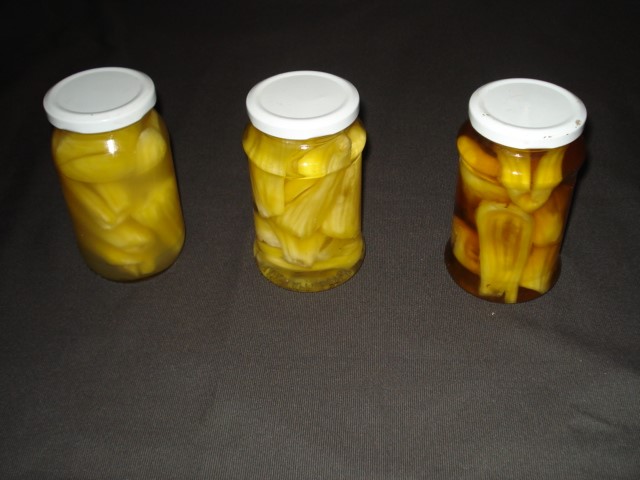
The jackfruit (Artocarpus heterophyllus L.) is a tree species that belongs to the mulberry family (Moraceae). In South India, the jackfruit is a popular fruit ranking next to the mango and banana in total annual production. The total area under jackfruit in India is about 14,826 acres (6002.43 ha). It can be used both as a vegetable and as a delicious fruit during the season.
Every year, the surplus production of jackfruit goes to waste due to a lack of proper post-harvest processing technology and practice. Jackfruit is fully covered with spines and hence poses problems in handling. Jackfruits are classified as koozhachakka (soft bulbs), which often go as waste and crisp bulbs of high quality known as varika, in South India. Though the former cannot be used as such for bulb consumption, it can be used in the form of pulp.
Pasteurization is a mild heat treatment given to foods, less intensive than sterilization, which is sufficient to inactivate particular health hazardous and food spoilage microorganisms.
Hence, specific post-harvest technology for reducing the post-harvest losses and to increase the shelf life of jackfruits was carried out for firm jackfruit bulbs in cans, pouches and bottles with sugar syrup, jaggery syrup, and jackfruit pulp of 20, 25, and 30° B concentration, thermally treated at 85°, 90°, and 95° C for a predetermined time. The physical properties viz., length, breadth, thickness, surface area, and weight of bulbs of firm variety were higher than the soft variety. The bulb (45.57 %) and rind (34.77 %) on a weight basis were higher in firm variety whereas, the yield of pulp (63.21 %) was more for soft variety. Since the yield of pulp was more for soft variety, the pulp of soft variety was used as one of the covering media with other covering media viz sugar syrup and jaggery syrup.
Biochemical properties of firm variety of fresh jackfruit bulbs recorded: -
- Acidity - 0.16
- pH - 5.64
- Total Soluble solids (TSS) - 13° B
- Total Sugars - 13.23 %
- β–carotene - 29.1 μg/100g
- Ascorbic Acid - 5.46 mg/100g
- Reducing Sugars 7.42 %
- Moisture Content - 75.88 %
The moisture content of packaged, processed, and preserved jackfruit bulbs decreased irrespective of processing temperatures adopted, the concentration of covering media used and the storage period studied. The jackfruit bulbs packaged in cans along with jackfruit pulp of 20° B processed at 85° C and stored for 12 months recorded a maximum moisture content of 62.12 % (wb) and all the other treatments recorded lower values only.
The pH of jackfruit bulbs packaged in cans recorded values between 3.80 and 3.85; in pouches, it recorded values between 3.77, and 3.8 and in bottles, it ranged between 3.91 and 3.96. As these pH values are in the medium acid range, food spoilage microorganisms including Clostridium botulinum cannot survive under this condition.
The total sugars of jackfruit bulbs in cans recorded values in the range of 17.25 to 24.10 % after 12 months of storage; in pouches, it recorded values between 16.81 and 22.64 % after nine months of storage and 16.61 to 19.34 % in bottles after six months of storage
Jackfruit bulbs in jackfruit pulp of 20° B, packaged in cans, processed at different temperatures, and stored for different periods recorded higher values of biochemical constituents than similar treatments in pouches and bottles.
In the case of ascorbic acid, the jackfruit bulbs packaged along with jackfruit pulp of 20° B in cans and processed at 85° C recorded a maximum value of 3.52 mg/100g immediately after thermal processing and 1.20 mg/100g after 12 months of storage which was higher than all other treatments.
The beta carotene, a precursor of vitamin A which also gives the attractive yellow colour to the jackfruit bulbs was maximum (27.12 μg/100g) in the jackfruit bulbs packaged along with jackfruit pulp of 20° B in cans, processed at 85° C and stored for 12 months. All other treatments recorded lesser values only.
The colour (‘b’ value) of fresh jackfruit bulbs in the Hunter colour meter was 54.45. Among all the treatments studied jackfruit bulbs in jackfruit pulp of 20° B, packaged in cans, processed at 85° C, and stored for 12 months recorded a maximum ‘b’ value of 54.14, which was almost equal to that of fresh bulbs.
The texture (cutting force) of jackfruit bulbs packaged along with jackfruit pulp of 20° B in cans, processed at 85° C, and stored for 12 months recorded a maximum cutting force value of 1996.2 g. All the other treatments studied recorded lower values only.
Among the different treatments conducted in cans, the microbial load range varied from 5.11 to 5.46 log cfu/g. The jackfruit bulbs stored in pouches and bottles recorded higher values of microbial load in the corresponding treatments and storage period than in cans.
The organoleptic evaluation studies conducted using jackfruit bulbs packaged along with jackfruit pulp of 20° B in cans, processed at 85° C, and stored for 12 months recorded a score value of 8.2 under overall acceptability and fresh jackfruit bulbs recorded a value of 8.4. This means that the processed bulbs are qualitatively lying between ‘like extremely’ and ‘like very much’ by the consumers.
Optimization of process parameters revealed that the jackfruit bulbs (firm type) packaged in cans along with jackfruit pulp of 20° B (pulp made out of bulbs of soft type), processed at 85° C retained many of the quality parameters (biochemical constituents) as compared to all other treatments and adjudged as the optimized process for the post-harvest processing of jackfruit bulbs.
The cost of production of one kg of jackfruit bulbs in cans (following the optimized process of production) was found to be Rs. 41.62 per can (1kg) and recorded a shelf life of one year. From the cost analysis, it is found that the break-even point is 674 cans/ year and the pack period is 2.48 years.

Cans filled with jackfruit bulbs in pulp, sugar and jaggery syrup

Retort pouches filled with jackfruit bulbs in pulp, sugar and jaggery syrup

Glass bottles filled with jackfruit bulbs in pulp, sugar and jaggery syrup
(Content shared by Dr. P. Sudha, Dr. R. Kailappan, Department of Food Process Engineering, Agricultural Engineering College and Research Institute, Tamil Nadu Agricultural University)